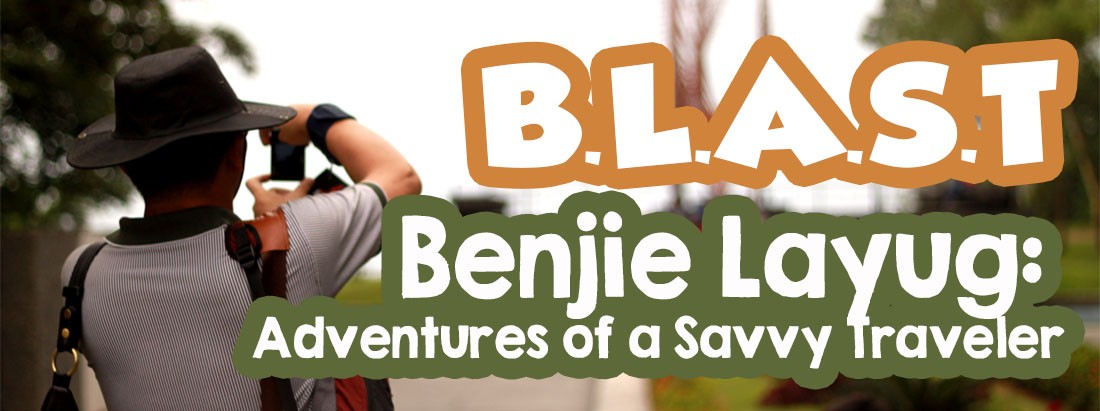Part of Sorsogon Countryside Tour
After breakfast and checking out at Residencia del Hamor Casiguran, we again boarded our coaster for 56.4-km. (1-hr.) drive to Matnog Port, the jump off point to the southern Philippines and vice-versa. From here, we were to explore the three of the town’s outlying islands – Juag Island Calintaan Island and Murong Burongan Island.
Check out “Hotel and Inn Review: Residencia del Hamor Casiguran”

Matnog Tourism Office
Upon arrival at Matnog Tourism Office, we had to first register ourselves. Then, we attended a 5-min. briefing (on proper waste disposal and the importance of keeping the beach clean) before boarding our respective motorized outrigger boats at Matnog Port. There were seven of us plus two boatmen and a security escort. Our first destination was to be Juag Island where the Juag Lagoon Fish Sanctuary is located. The boat trip from the port to the island took about 20 mins. and, as we neared the island, we were greeted by a stunning scenery of white sand beaches, mangrove tress and coconut trees.

Matnog Port
Privately owned and maintained (by the Geneblazo family headed by Mr. Alex Geneblazo, Juag Island has an area of 572 sq. m. and is home to 40 fish species. It was started in 2000 with a few pairs of bangus (milkfish) fed with seaweed.

The author (right) with is companions
Despite being privately owned, the family decided to open it up to the public to educate and entertain, thereby contributing towards the conservation of aquatic species and marine environment by protecting several aquatic animals and plants in a sanctuary.
Residing on the shore of the sanctuary, he and his family are and have made great efforts in providing the marine creatures with a healthy habitat and environment to grow and multiply. The Geneblazo family does not charge an entrance fee to the property but donations for the maintenance of the sanctuary are very welcome.
The sanctuary, nothing like a fish farm, aims to make people aware of as well as to protect and conserve aquatic life, helping tourists understand the importance of marine biodiversity. It prides itself with a wide variety of beautiful marine animals and aquatic species.
To protect the variety of species enclosures of bamboo are built inside which the species move freely in herds. Each enclosure holds different aquatic creatures that are raised by Sir Alex and his family, along with their caretakers. Touring the sanctuary made us experience the significance of protecting the beautiful marine life.
The first bamboo platform is used for briefing the visitors on what not to do while exploring the sanctuary. Here, we got to view underwater coral fishes, reefs and other aquatic weeds and plants.
No diving is allowed since it might distract the fishes but visitors are allowed to swim with the fishes as long as the influx of travelers is controlled. They allow tourists to go there by batch. Here, we got to feed the fish with fish pellets, small fish and bread.
When it was our group’s turn, we hopped on this bamboo raft and, guided by ropes, crossed the sanctuary leading, from the owners’ hut, into a second bamboo platform on stilts in the middle.
This platform contained the real giants of Juag – namely large baraka/lapu-lapu (brown marble grouper), mameng (Napoleon wrasse) and mamsa/talakitok (trevally or big-eyed jack) as well as bangus (milkfish), dugso (long nose emperor), saploran/maya-maya (emperor red snapper), loro/kalolong (parrotfish), pasingko/maynila (Goldman sweetlips), bayang (long-fin batfish), angelfish, labahita (surgeonfish), alatan (harlequin sweetlips) and maramara/samaral (orange-spotted spinefoot).
Donning our snorkels, we were allowed to swim with the fishes in the shallow, crystal-clear waters. However, they have a strict no-sunblock policy to avoid poisoning the fishes.
I also posed for the camera carrying a huge balat (pineapple sea cucumber, Thelenota ananas), There are also pawikan (sea turtles), starfishes, banagan/banahawon (tiger lobsters) and taklobo (giant clams).
Juag Lagoon Fish Sanctuary: Matnog, Sorsogon. Mobile numbers: (0907) 957-7748 and (0918) 304-5437. Fish pellets can be bought (php35/kg.) from a sari-sari store near the feeding area. Facebook page: http://juaglagoon.wix.com/sanctuary
https://www.facebook.com/JuagLagoonMarineSanctuary
How to Get There: Matnog is located 575.9 kms. (a 13.25–hr. drive) from Manila and 61.2 kms. (a 1–hr. drive) from Sorsogon City, both via the Pan-Philippine Highway/AH26..Manila to
Matnog by Bus:
There are several bus liners going straight to Matnog including Philtranco, Penafrancia, Raymund and Amihan. The trip takes 12-15 hours depending on the traffic.
Manila to Legazpi City by Air:
Cebu Pacific Air and Philippine Airlines fly daily to Legazpi City from Manila. Legazpi City is about an hour travel by plane from the capital.
Legazpi City to Matnog:
To get to Matnog from Legazpi City, ride a tricycle going to the bus terminal located near Gaisano Mall. Ride the bus bound for Sorsogon. From Sorsogon, ride the jeepney heading to Matnog and ask to be dropped off near the port. From Matnog Pier, it is a 20-min. motorized boat ride to Juag.
Sorsogon Provincial Tourism Culture and Arts Office: Ground Floor, Capitol Building, 4700 Sorsogon City. Mobile number: (0968) 624-6279. E-mail: tourism@sorsogon.gov.ph. Facebook: www.facebook.com/sorsogonprovincialtourismoffice.
Matnog Tourism, Culture andArts Office: Brgy. Camcaman, Matnog 4708, Sorsogon. Mobile number: (097) 231-8168. Facebook: www.facebook.com/Matnog Tourism. Fees: Environmental Fee: Php20/pax and Php16 (senior citizens). Registration Fee: Php320 (foreigners), Php70 (locals) and Php40 (senior citizens).
Ur Place Travel & Tours: OLV Pangpang, Sorsogon City, Sorsogon. Mobile number (Viber): (0927) 950-3927 (Ms. Annie Gueb). Facebook: www.facebook.com/urplacetravel.






























































































































































